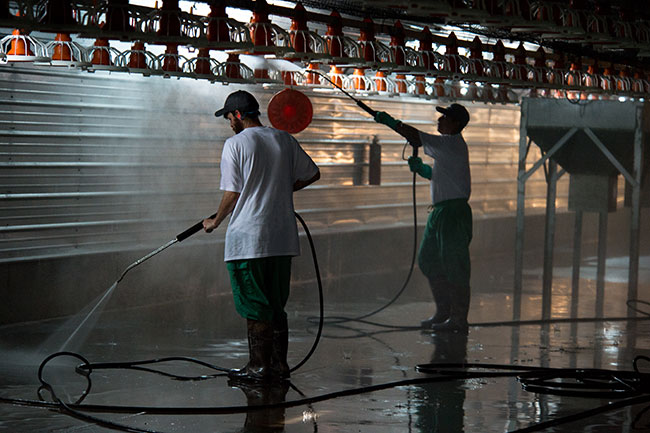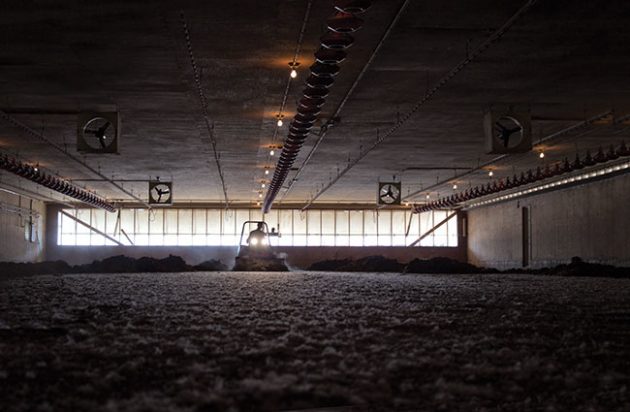
Effective cleaning and disinfecting best practices
By David Van Walleghem
Features Barn ManagementFollow these steps to make this important biosecurity practice is as beneficial as possible.
 Some producers skip or improperly perform important steps with cleaning and disinfecting, compromising the process.
photo credit: Aviagen
Some producers skip or improperly perform important steps with cleaning and disinfecting, compromising the process.
photo credit: Aviagen Biosecurity is a living science and a big buzzword involving many aspects of animal production. This article takes on one of the most important parts of biosecurity – cleaning and disinfecting.
Pathogens are everywhere and can develop quickly to become overwhelming, especially to new stock in an environment. The more producers can reduce these pathogens the more energy they can redirect towards the growth and production of their animals.
Cleaning and disinfecting sounds like a simple process that producers do every day. But sometimes, they miss parts of steps or improperly perform them and the effectiveness of the process is compromised. Let’s break it down and explain each step and its importance so producers can get the most efficient and effective cleaning and disinfecting possible.
Step 1. Organic removal
Removing most of the bulk organics – litter, manure, spent feed, etc. – is an important first step. That’s because a bulk of the pathogens survive and thrive off of the organics. Scrape, shovel or even bulk wash it away. If you are using water, make sure you remove puddles and wait until the surface dries to allow the pores to drain out. After this the surface may look clean. However, the pathogens left have made a biofilm to protect them from any possible invasion. This biofilm is a very sticky matrix, which detergent was purposely made to remove.
Step 2. Detergent application
COVID-19 has highlighted how important the detergent application step is in controlling pathogens. Livestock operations use two main types of detergent products: Degreaser, a product with high in pH used to help break up and remove the organic biofilms that protect the pathogens; and descaler, a product low in pH use to help dissolve the minerals deposited on surfaces that can hide and protect pathogens also.
Poultry producers are mostly challenged with the organics. Thus, they more commonly use degreaser while occasionally rotating to descaler when the mineral is evident. Producers should only use one of these products at a time with a power wash between them. Once they’ve chosen the right product, farmers should refer to the following rules to get the most out of the detergent:
Rule 1: Apply on all surfaces to be washed. Use the right amount according to the label. If producers are using an applicator that draws from a stock solution, they should make sure the stock is concentrated properly so that the product produced to apply on the surface is what is on the label. If farmers are unsure how to perform this, they can watch a video of an expert performing the test at biosecurity.vetoquinol.ca under the Videos & Training tab.
Rule 2: Use low pressure spray or foam. This ensures that the product sticks to the surface. The air bubbles in the foam help the product stick to smooth surfaces and the spray is great for penetrating porous surfaces.
Rule 3: Give detergent time to work. Its job is to break the biofilms into smaller parts and then surround them in the product in what is called a micelle. If producers are pressed for time or there is a stubborn stain, manual scrubbing will help with the formation
Rule 4: Remove solution before it drie. This step is the most forgotten one and is very important for success. Micelles only stay in that form if floating in water. If they’re dehydrated they cannot hold on to the biofilm and redeposit back on the surface. For this reason, if producers have a large facility, it is best to soap and wash in sections small enough so it does not dry to get the best clean.

Removing bulk organics like litter and manure is an important first step.
PHOTO CREDIT: Ventrac
Step 3. Disinfecting application
Even though producers will have taken a huge load of microbes away by this point, there still could be enough to hinder their next flocks’ development or even make them sick. Thus, it is important to apply disinfectant. When doing so, follow these simple rules:
Rule 1: Choose the right disinfectant. Producers should pick the right product according to their challenge. If they are unsure about which one to use for their particular challenges and environment, farmers can contact their veterinarian or biosecurity specialist for help.
Rule 2: Prepare the environment. To give it the best chance for success, make sure the environment is right. At this point, producers have given themselves a huge start by cleaning with a detergent. Now, ensure the surfaces do not have puddles of water and the surfaces pores are open so that the disinfectant can penetrate them.
Rule 3: Ensure proper concentration. If producers are using an applicator with a stock tank, they should make sure the concentration is correct to allow the contact product be what is indicated by the label.
Rule 4: Use low pressure or foam. This ensures that the disinfectant will stick to the surfaces long enough to do the killing (also indicated on the label).
Rule 5: Let it dry after application. The drying effect will help with further control of microbes.
Cleaning and disinfecting is an everyday task that producers regularly perform. Hopefully, breaking it down in to the primary blocks of actions with the reasoning for them makes farmers focus on better cleaning and disinfecting to allow their animals to use their energies to express their full genetic potential.
Again, this is only one of the many steps producers must take in biosecurity control. That said, if they follow the proper steps, cleaning and disinfecting is a great investment for their birds.
David Van Walleghem is biosecurity specialist, production animals with Vetoquinol.
Print this page